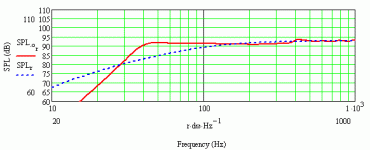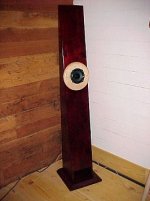I have never built a speaker before, but I want to give it a try around a pair of Foxtex FE206E drivers. The Cain and Cain Abby is my inspiration. Is there a public domain plan for it? Any other suggestions? My goal is to build a speaker the favors jazz and vocals.
I currently have a Golden Tube SE-40 Special Edition that I have modified to use all paper in oil caps. I have a Basie pre-amp from DIY HiFi Supply that I built with all the upgrades they offer. I have a Linn Genke CD player and Vandersteen 2c signature speakers. My room is 25 feet wide by 35 feet deep. Acutally it is open to the kitchen which gives a depth of 55 feet. Its an older house so the height is only 8 feet.
Thanks in advance for any feedback.
I currently have a Golden Tube SE-40 Special Edition that I have modified to use all paper in oil caps. I have a Basie pre-amp from DIY HiFi Supply that I built with all the upgrades they offer. I have a Linn Genke CD player and Vandersteen 2c signature speakers. My room is 25 feet wide by 35 feet deep. Acutally it is open to the kitchen which gives a depth of 55 feet. Its an older house so the height is only 8 feet.
Thanks in advance for any feedback.
You'd probably be better off posting in the full range forum. However...
The Abby uses the FE166E (the Nearfield & Super Abby's used the FF165K) & is an ML TQWT. The designs are not public domain, and frankly, you wouldn't be missing out on much because the actual line is sub-optimal. Terry Cain was a genius with materials & the cabinets were tuned as much (probably more) through careful selection of these than any real QW theory. Valid take, but if you tried to replicate his exact pipe, it won't work as well as you're not using the same materials.
If you want something true to the look but with better performance (assuming you don't have TC's materials knowledge), then something like this should do. It's using the FE167E, rather than the FE166, which is a better match to this sort of cabinet. Internal dimensions:
70in x 7.5in x 12in (HxWxD at base) Tapers to a point at the top (what's called an So=0 design if you're interested). Driver-centre is mounted at the 0.5 line length point, 35in from the point & the base. Circular port 3in diameter x 3in long, 4in up from the internal base. Either line the rear & one side-wall of the cabinet with your favourite damping material from the top 40in down, or stuff 0.45lbs ft^3 of hollow-fibre material from the top 40in down. Quasi-anechoic response attached -should be ~flat to 40Hz. You can tailor the response in-room by adjusting the damping to taste if it's a little boomy (I prefer to design flat & let people tailor it to their own situation as every room is different). Might need a BSC circuit on it (something the Abby lacks) -depends on how far out into the room it is, but I doubt it in this case actually, based on what my current MLTLs with these drivers are doing.
You might also be interested in the Metronomes: http://www.frugal-horn.com/metronome.html
Hope that's of some use
Scott
The Abby uses the FE166E (the Nearfield & Super Abby's used the FF165K) & is an ML TQWT. The designs are not public domain, and frankly, you wouldn't be missing out on much because the actual line is sub-optimal. Terry Cain was a genius with materials & the cabinets were tuned as much (probably more) through careful selection of these than any real QW theory. Valid take, but if you tried to replicate his exact pipe, it won't work as well as you're not using the same materials.
If you want something true to the look but with better performance (assuming you don't have TC's materials knowledge), then something like this should do. It's using the FE167E, rather than the FE166, which is a better match to this sort of cabinet. Internal dimensions:
70in x 7.5in x 12in (HxWxD at base) Tapers to a point at the top (what's called an So=0 design if you're interested). Driver-centre is mounted at the 0.5 line length point, 35in from the point & the base. Circular port 3in diameter x 3in long, 4in up from the internal base. Either line the rear & one side-wall of the cabinet with your favourite damping material from the top 40in down, or stuff 0.45lbs ft^3 of hollow-fibre material from the top 40in down. Quasi-anechoic response attached -should be ~flat to 40Hz. You can tailor the response in-room by adjusting the damping to taste if it's a little boomy (I prefer to design flat & let people tailor it to their own situation as every room is different). Might need a BSC circuit on it (something the Abby lacks) -depends on how far out into the room it is, but I doubt it in this case actually, based on what my current MLTLs with these drivers are doing.
You might also be interested in the Metronomes: http://www.frugal-horn.com/metronome.html
Hope that's of some use
Scott
Attachments
Thanks for the reply and for the design idea. I guess I didn't give the impression I intended. After all I am just a newbie. I listed the Abby specifically, but it is just my inspiration. I know that the Abby uses the FE166E, but the Cain-Cain site lists the FE206E and it appears to have a flatter response. And, I found a place that sells them. I will look for information about the FE167. Your response talks about a baffle, but does not say where it is located or what its shape is. Also, I was thinking of using furniture grade plywood. What are your thoughts on that? How thick should it be?
thoburnse40 said:Also, I was thinking of using furniture grade plywood. What are your thoughts on that? How thick should it be?
When looking for plywood, you want 2 things -- lots of plys, and no voids. 18mm Baltic Birch has 13 layers (and is what we use)
Some broad generaizations:
The FExy6 drivers typically need a horn to get the best out of them, the FExy7s are happier in more conventional boxes.
FExy7s tend to be smoother than FExy6 but don't have quite the dynamics.
As the drivers get bigger efficiency tends up, bass gets more extended, dynamics get better, boxes get bigger but the mids, top & finesse suffer.
Which one is best depends on what & how you listen to music, and any space/WAF constraints you have.
For me, the sweet spot are the 4-5" drivers.
dave
BTW... a friend has Abbus. I was not all that impressed with then with the FE166. They seem better with FF165 (but these are with stock drivers, and i've been spoiled by modded drivers)
No commercial Cain & Cain box ever used the FE206E. The FR drivers commercially used were: the FF85K, FE108ESigma, FF165K, FE166E, FE168Sigma (rapidly replaced by the FE168ESigma), and FE208ESigma. Terry Cain might have used it in one of his numerous DIY projects, but that's all. They FExx6E series are not ideal in a resonant cabinet without some form of correction; the FExx7E drivers are better, as Dave notes.
There are plenty of sources of all the Fostex drivers -Madisound, Solen, DaveP10 who replied above etc & does modifications which massively improve the performance of the units over the stock drivers. So have a browse around. In terms of the driver response the 166 is flatter than the 206 (though of course it doesn't go as low). Frankly, I'm not much of a fan of the 166 though -it's a little sharp across the midband -the 167 is the better unit IMO. As Dave notes, the smaller drivers are smoother still, but you've got a pretty big space & they'd stuggle to fill it.
Re the material, 18mm BB or apple ply as Dave says is about the best of the plywoods. FWIW, when Terry Cain built his first TQWT (it was a DIY box, before he started selling speakers) he used ply for the sides, chipboard (particleboard) for the rear baffle and solid alder for the front. IIRC, it was all 3/4in thick. He added the circular false baffle, made of 1in maple I believe. A shot of the result is attached below, with a lovely purple dye / stain.
BTW -the above enclosure will take the FE207E is you wanted an 8in unit, no changes needed.
There are plenty of sources of all the Fostex drivers -Madisound, Solen, DaveP10 who replied above etc & does modifications which massively improve the performance of the units over the stock drivers. So have a browse around. In terms of the driver response the 166 is flatter than the 206 (though of course it doesn't go as low). Frankly, I'm not much of a fan of the 166 though -it's a little sharp across the midband -the 167 is the better unit IMO. As Dave notes, the smaller drivers are smoother still, but you've got a pretty big space & they'd stuggle to fill it.
Re the material, 18mm BB or apple ply as Dave says is about the best of the plywoods. FWIW, when Terry Cain built his first TQWT (it was a DIY box, before he started selling speakers) he used ply for the sides, chipboard (particleboard) for the rear baffle and solid alder for the front. IIRC, it was all 3/4in thick. He added the circular false baffle, made of 1in maple I believe. A shot of the result is attached below, with a lovely purple dye / stain.
BTW -the above enclosure will take the FE207E is you wanted an 8in unit, no changes needed.
Attachments
- Status
- This old topic is closed. If you want to reopen this topic, contact a moderator using the "Report Post" button.

